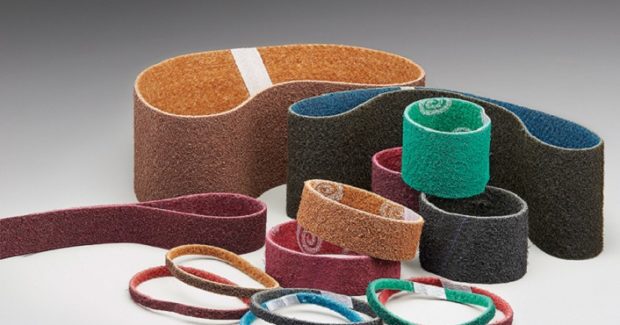How Proprietary Grains Optimize Non-Woven Abrasives for Superb Finishes
Take a closer look at how a Midwest appliance manufacturer used non-woven agglomerated grain technology to put a structured cosmetic finish on a ring for a high-end kitchen appliance, remove the medium-sized burrs left on the ring from stamping, and increase their productivity by 5X!
Posted: September 20, 2018
Over the years, the finishing industry has seen the growth of non-woven technology in nearly every field. From aerospace, automotive, decorative/cosmetic finishing, medical and many others, the unique finish that is obtained when using non-woven abrasives fills some very important requirements for finishing. The ability to put a structured finish on the surface of a component without the need for messy, inconsistent greaseless compound is just the tip of the advantage that non-woven technology offers. While final structured finishes are still a major component in the overall market of non-woven products, metal removal has become an important role for this unique product.
GRAIN ADVANTAGES
Much of this improvement is possible due to the very effective Vortex grain that is used in various non-woven belts, wheels and pads. This exclusive agglomerated grain consists of a non-structured nylon mesh material that suspends the grain in a unique way, unlike how the grain is presented on a conventional coated belt. This allows for a continuation of cut rate and a highly consistent finish due to the unique design of this grain family. When in a wheel form, the agglomerated structure allows for a high cut rate and longer life in low and high density unified wheels. This is effective when comparing non-woven unified wheel processes to other types of wheels, including bonded wheels. The fast-cutting long-life grain, when placed in a format of smear-free Clean Bond® technology, allows for high pressure applications with little to no concern that the heat generated when grinding will break down the structure of the wheel bond.
When used in low density wheels, the grain allows for fast cutting and long life for finishing hard-to-reach or contoured parts. For flat parts, non-woven belts are available for a straight and structured finish. For example, Norton Vortex Rapid Prep™ belts have the ability to replace greaseless compound applications as well as improve the performance of non-woven belts that do not have the Vortex agglomerated grain technology. For areas that have a tight radius, wheels of different densities are effective. For smooth structured finishes, non-woven flap wheels or interleaf wheels are a good approach. The interleaf wheel is a combination of non-woven material and coated abrasives that are available in an extensive number of configurations. The ability to customize non-woven material with various coated abrasive grains and grit sizes means that nearly any current finish can be matched with the non-woven method.
Customization also makes automation a real possibility. No matter the expected final finish, with interleaf technology and capability a better finish can be attained that is also suitable for robotic/ automated operation. Full repeatability and consistency that has not been possible with the greaseless compound and buff method can be achieved with automation. With improvements made by numerous robot integrators, the ability to “read” the size of the wheel as it wears allows for wheel speed and pressure adjustment. These capabilities enable the operator to create an exact finish for each and every part. Cost savings add up when converting from old finishing methods to a non-woven technology due to the advantages of the Vortex agglomerated grain and the non-woven structure.
PRODUCTION REVOLUTIONIZED
One example of how Vortex non-woven agglomerated grain has helped revolutionize production occurred when a Midwest finishing operation needed to put a structured finish on a ring used on a high-end kitchen appliance. This required not only a cosmetic finish, but also the removal of some medium sized burrs that occurred during the stamping process. To get the operations started, the finisher was supplied with standard Rapid Prep non-woven belts in medium grit. This process worked great when used on a serrated rubber contact wheel, providing both the burr removal and the required finish. However, the cost of the non-woven belts and the number of parts it could produce was too high for the small finishing shop. With both burr removal and finish, only 300 to 400 parts could be produced per belt, which was not enough. The next step was to try a competitive belt that was coarser in order to achieve more belt life. This increased the yield to 500 parts per belt, but the finish was unacceptable.
To extend the life of the belt by reducing the adverse effects of heat, a solid belt lubricant was used on the original Rapid Prep belt and extended belt life to 600 parts per belt. A substantial improvement, but the cost per piece was still too high. To get more from the process, the shop switched to the Vortex version of the Rapid Prep belt. With a continuation of solid lube, this raised their production to 1,200 pieces per belt, although they were at a break-even cost point based on the quoted price. They then took this same Vortex Rapid Prep belt and used a coarse coated abrasive fiber disc to “dress” the belt after about one-quarter of the life. This was possible due to the multi-layer nature of the belt. The process to clean and bring new fibers to the surface extended the belt life to approximately 1,500 pieces per belt. Finally, the shop switched to “Cool It”™ Lube Liquid belt lubricant, which resulted in a minimum of 1,800 pieces per belt with the continued dressing process.
A summary of the optimization of the kitchen appliance component finishing reads as follows:
Producing 5X More Parts Per Belt
- Rapid Prep Non-Woven Belt finished 300 rings per hour to start.
- Rapid Prep Non-Woven Belt finished 600 rings per hour with solid belt lubricant.
- Vortex Rapid Prep Non-Woven Belt finished 1,200 rings per hour with continued solid lubricant/ belt dressing.
- Vortex Rapid Prep Non-Woven Belt finished 1,800 rings per hour with Liquid Cool It lube and belt dressing.
















